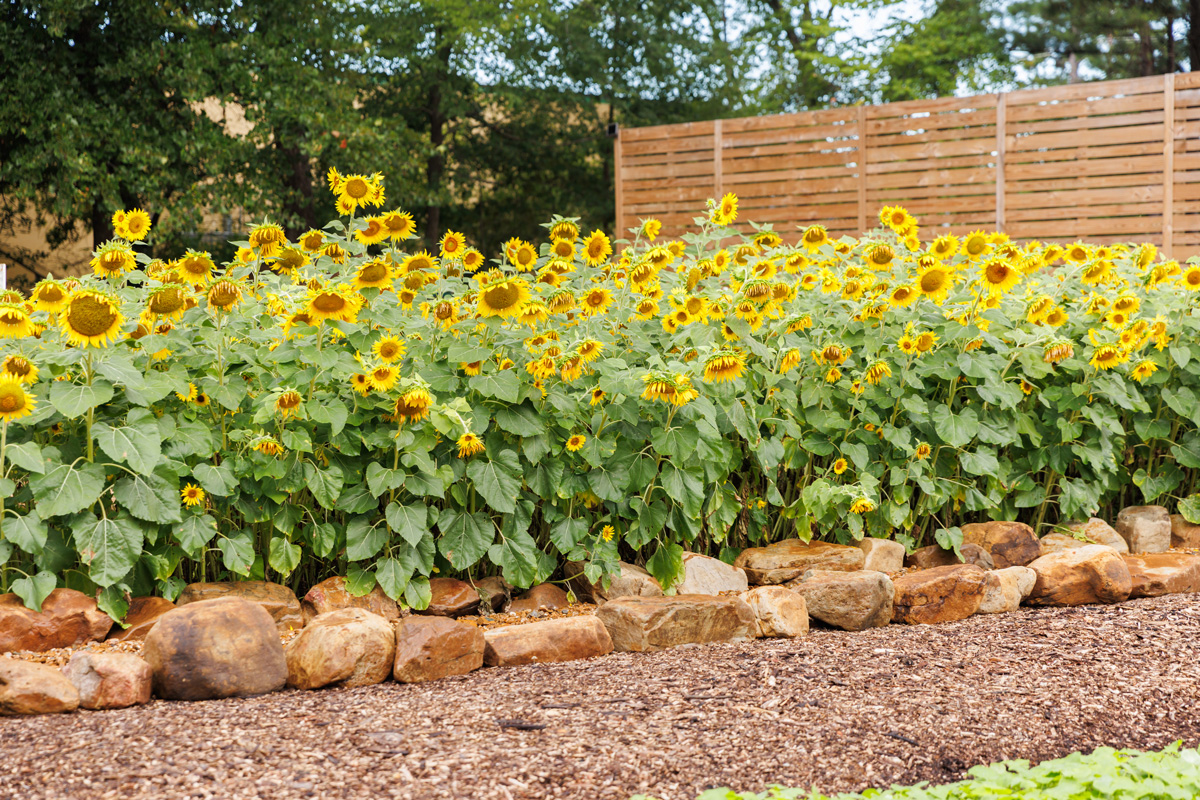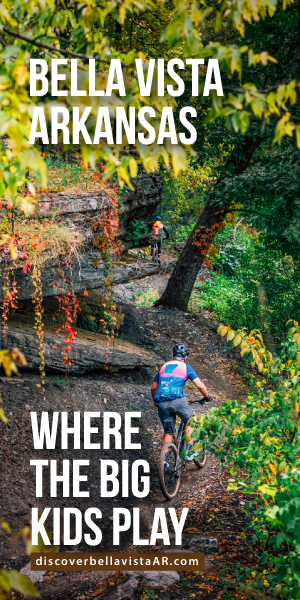Arkansas Unbound
Exploring the State’s Unique Outdoor Pursuits
Rallycross, Foraging and Urban Gardening Redefine Your Autumn.
By Becca Bona

Chris Hyriack tends to his Central Arkansas urban farm, where even a small plot of land can flourish into a thriving oasis of native plants and fresh produce. - Photography by Sara Reeves
With its many trails, rivers and peaks, The Natural State begs traditional outdoor activities like hiking, hunting and camping. Yet, there are so many alternative ways to find connection with Mother Nature. Whether it’s the adrenaline-fueled rush of rallycross through the Ozarks, the quiet, meditative pursuit of foraging in the forest’s understory or the cultivation of green oases in urban gardens, these activities offer fresh perspectives on what it means to experience the outdoors in Arkansas.
This article explores how rallycross allows drivers to connect with the rugged terrain, how foraging opens up a deeper appreciation for the state’s rich biodiversity and how urban gardening, on the other hand, brings the beauty of nature to city dwellers, creating green spaces that nourish both body and soul. Read on for more.
Sowing in Small Places
Photography by Sara Reeves
Urban farming offers a unique opportunity for city dwellers to reconnect with the land, even in the smallest of spaces. As Chris Hyriack, an avid urban farmer based in Central Arkansas, shares, the beauty of gardening lies in its accessibility and the deep connection it fosters between people and nature.
“It starts with that first plot or that first small garden,” Hyriack said. “Be careful, though, because it can spiral out of control.” He first started urban farming over 20 years ago, largely because he witnessed the work his neighbor was able to accomplish in his backyard. Hyriack set to work with a small 10-feet-by-20-feet garden, which eventually blossomed into an urban farm that spans nearly an acre, filled with native plants, vegetables and greenhouses. His journey highlights that anyone can start small and still significantly impact their health and community.

“A lot of folks think gardening ends in August, but there’s so much you can do in the fall,” he said. In Arkansas, with its long growing season, the opportunities are abundant. “By August, you should be preparing for your fall crops,” Hyriack advises. “It never really stops; there’s always something to plant or harvest.”
Fall is the perfect time to plant leafy greens, root vegetables and even some late-season tomatoes. Hyriack emphasizes the importance of using high-quality compost and mulch to prepare the soil, ensuring that the garden thrives even as the weather cools.
Hyriack’s approach to urban farming is holistic, emphasizing the physical benefits and the mental and emotional well-being of working the soil. “Horticultural therapy is real,” he says. “It’s the physical activity of gardening that’s beneficial, but it’s also about the environment you create around you. Just having a space filled with plants can be incredibly calming.”
Hyriack is passionate about making gardening accessible to everyone, from those with large backyards to those with just a small balcony. He’s even crafted cedar boxes on casters to allow for mobile container gardening, perfect for urban spaces. For Hyriack, the act of gardening goes beyond just growing food — it’s about creating a sanctuary.
“Even in a small space, you can create a refuge from the hustle and bustle of city life,” he says. “It doesn’t feel like I’m in the middle of the city when I’m in my garden. It’s a slice of heaven.”
There’s an avid, active community of urban gardeners and farmers across The Natural State. “Gardening has allowed us to interact with so many folks in our neighborhood that we might not have otherwise,” he said. Whether it’s trading vegetables with neighbors or sharing gardening tips, the sense of connection is strong. “There’s something about gardening that attracts people — it’s very instinctual. We feel safe in a garden, surrounded by life and abundance.”
Hyriack offers simple yet powerful advice for those new to urban farming: Start small and enjoy the journey.
“There’s incredible success to be had by just putting some seeds in the soil and trying,” he said. “Fall is often overlooked, but it’s one of the best times to garden. So get out there, start small and see where it takes you.”
Whether you have a sprawling backyard or just a few feet of balcony space, the potential for growth — both of plants and of personal well-being — is immense.
“It doesn’t feel like I’m in the middle
of the city when I’m in my garden. It’s a slice of heaven.” – Chris Hyriack
Hidden Harvest
Photography by Sara Reeves
Get ready to stalk the wild side — mushroom foraging turns a walk in the woods into a treasure hunt. In The Natural State, where the landscape is rich with diverse flora, mushroom foraging has gained interest, particularly among those seeking to connect more deeply with the natural world. Jay Justice, senior epidemiologist at the Arkansas Department of Environmental Quality and president of the Arkansas Mycological Society, emphasizes the importance of learning from experts when starting out.
“Seek out at least one individual who is a recognized and bona fide expert in identifying mushrooms in Arkansas,” he said. This knowledge is crucial, as correctly identifying mushrooms can be the difference between a delightful meal and a dangerous mistake.
Justice highlights some of the more common and easily identifiable mushrooms in Arkansas, such as chanterelles, oyster mushrooms, and puffballs, which are popular among local foragers. “Chanterelles are the most common and widespread edible mushrooms in Arkansas,” he said. “They have a lengthy growing season, from June to September, and are easy for most folks to learn how to distinguish from a couple of look-alikes.”
However, Justice cautions against relying on AI apps for identification, as misidentifying a mushroom can have serious consequences. “When in doubt, throw it out,” he advises, echoing the time-tested wisdom of seasoned foragers.

For novices like Justin Vess and Rachel Tanner, mushroom foraging has become a way to connect with the outdoors in a meaningful and fulfilling way. Vess became a Master Gardener, and afterward was interested in learning even more about the local naturescapes around him. Both Vess and Tanner are Arkansas natives, and they initially began foraging as an extension of their casual hiking, but quickly found themselves drawn deeper into the practice.
“We always say it’s kind of like our version of hunting,” Tanner said, referencing their vegetarian lifestyle. For them, the thrill of the hunt isn’t about the kill but about discovering and harvesting wild food from the land. Vess added, “We were used to being outdoors for fun, but foraging made us focus on what’s around us in a way we hadn’t before.”
Their foraging journey led them to attend workshops and classes, including one led by Justice. “The first class we took with Jay was specifically for morel hunting,” Vess recalled. Morels are highly prized for their unique flavor but are notoriously difficult to find.
“In Arkansas, there’s nothing that looks like a morel that is poisonous,” Vess said, making them a safer choice for beginners. The couple often travels to the Ozarks during morel seasons, as the terrain and conditions are ideal for finding these elusive mushrooms.“It’s like a treasure hunt,” Tanner said, “You never know when you’ll find something.”

One of their most memorable foraging experiences was during a dry season when mushrooms were scarce. Despite the conditions, Tanner made an incredible find: a massive Chicken of the Woods mushroom growing along the side of a dirt road. “At first, I thought it was trash, like Styrofoam or something,” she laughed. “But when I got closer, I realized it was this huge, vibrant mushroom. It was like finding a seven-point buck in the mushroom world.”
The find was the highlight of the foray, and other seasoned foragers celebrated with her, offering recipes and tips on preparing the mushroom. “I felt like a superstar,” Tanner said, beaming at the memory.
The couple’s passion for foraging extends beyond the hunt itself. They have become active members of the local foraging community, attending regular forays and participating in group events.
“The community around mushroom foraging in Arkansas is really special,” Tanner said. “We’ve met so many knowledgeable and enthusiastic people who are always willing to share what they know.” There are plenty of active Facebook groups, including Arkansas Mushrooms and Fungi as well as The Original Arkansas Morel Hunters.
For them, mushroom foraging isn’t just about gathering food; it’s about being part of a community that values knowledge, respect for nature and the joy of discovery. “It’s like an Easter egg hunt every time we go out,” Vess added. “And the best part is, you get to eat the eggs.”
Mushroom Soup
Soup from Driftwood Farms, recipe via My Forking Life.
Ingredients:
Blue Oyster Mushrooms: 4 Cups
Butter: 6 Tablespoons
All-Purpose Flour: 6 Tablespoons
Yellow Onion (Chopped): 1 Cup
Celery (Chopped): 1/2 Cup
Dried Thyme: 1 Teaspoon
Marjoram: 1 Teaspoon
Chicken Broth: 4 Cups
Heavy Cream: 1 Cup
Salt and Pepper: To Taste

Mushroom Soup - Photography by Sara Reeves
Instructions:
Melt butter in a large pot over medium heat. Add onion and celery and sauté until softened.
Add Driftwood Farms Blue Oyster Mushrooms, dried thyme, and marjoram. Stir until mushrooms have softened and reduced in volume, about 10 minutes. Sprinkle flour over the mixture and stir for about 1-2 minutes to allow the flour to cook.
Stir in chicken broth and simmer over medium heat for 10-15 minutes, until the mixture has reduced.
Reduce heat to low and stir in heavy cream. Allow mixture to simmer an additional 5 minutes. Remove from heat and season with salt and pepper.

Rallycross enthusiasts gather at events across the Natural State, where drivers from all walks of life compete in a variety of vehicles — from $500 Facebook finds to top-tier rally cars. - Photo by Jon Seaton @dashmanofficial
From Gravel to Glory
Photography by Jon Seaton @DashManOfficiaL
Get ready to stalk the wild side — mushroom foraging turns a walk in the woods into a treasure hunt. In The Natural State, where the landscape is rich with diverse flora, mushroom foraging has gained interest, particularly among those seeking to connect more deeply with the natural world. Jay Justice, senior epidemiologist at the Arkansas Department of Environmental Quality and president of the Arkansas Mycological Society, emphasizes the importance of learning from experts when starting out.
“Seek out at least one individual who is a recognized and bona fide expert in identifying mushrooms in Arkansas,” he said. This knowledge is crucial, as correctly identifying mushrooms can be the difference between a delightful meal and a dangerous mistake.
Justice highlights some of the more common and easily identifiable mushrooms in Arkansas, such as chanterelles, oyster mushrooms, and puffballs, which are popular among local foragers. “Chanterelles are the most common and widespread edible mushrooms in Arkansas,” he said. “They have a lengthy growing season, from June to September, and are easy for most folks to learn how to distinguish from a couple of look-alikes.”
However, Justice cautions against relying on AI apps for identification, as misidentifying a mushroom can have serious consequences. “When in doubt, throw it out,” he advises, echoing the time-tested wisdom of seasoned foragers.

For novices like Justin Vess and Rachel Tanner, mushroom foraging has become a way to connect with the outdoors in a meaningful and fulfilling way. Vess became a Master Gardener, and afterward was interested in learning even more about the local naturescapes around him. Both Vess and Tanner are Arkansas natives, and they initially began foraging as an extension of their casual hiking, but quickly found themselves drawn deeper into the practice.
“We always say it’s kind of like our version of hunting,” Tanner said, referencing their vegetarian lifestyle. For them, the thrill of the hunt isn’t about the kill but about discovering and harvesting wild food from the land. Vess added, “We were used to being outdoors for fun, but foraging made us focus on what’s around us in a way we hadn’t before.”
Their foraging journey led them to attend workshops and classes, including one led by Justice. “The first class we took with Jay was specifically for morel hunting,” Vess recalled. Morels are highly prized for their unique flavor but are notoriously difficult to find.
“In Arkansas, there’s nothing that looks like a morel that is poisonous,” Vess said, making them a safer choice for beginners. The couple often travels to the Ozarks during morel seasons, as the terrain and conditions are ideal for finding these elusive mushrooms.“It’s like a treasure hunt,” Tanner said, “You never know when you’ll find something.”
One of their most memorable foraging experiences was during a dry season when mushrooms were scarce. Despite the conditions, Tanner made an incredible find: a massive Chicken of the Woods mushroom growing along the side of a dirt road. “At first, I thought it was trash, like Styrofoam or something,” she laughed. “But when I got closer, I realized it was this huge, vibrant mushroom. It was like finding a seven-point buck in the mushroom world.”
The find was the highlight of the foray, and other seasoned foragers celebrated with her, offering recipes and tips on preparing the mushroom. “I felt like a superstar,” Tanner said, beaming at the memory.
The couple’s passion for foraging extends beyond the hunt itself. They have become active members of the local foraging community, attending regular forays and participating in group events.
“The community around mushroom foraging in Arkansas is really special,” Tanner said. “We’ve met so many knowledgeable and enthusiastic people who are always willing to share what they know.” There are plenty of active Facebook groups, including Arkansas Mushrooms and Fungi as well as The Original Arkansas Morel Hunters.
For them, mushroom foraging isn’t just about gathering food; it’s about being part of a community that values knowledge, respect for nature and the joy of discovery. “It’s like an Easter egg hunt every time we go out,” Vess added. “And the best part is, you get to eat the eggs.”
“Rallycross is a safe way to get out in that field
and just let yourself rip the throttle. Every surface, from grass to gravel, brings a new challenge, and that’s what makes it so addictive.”
– Jon Seaton


